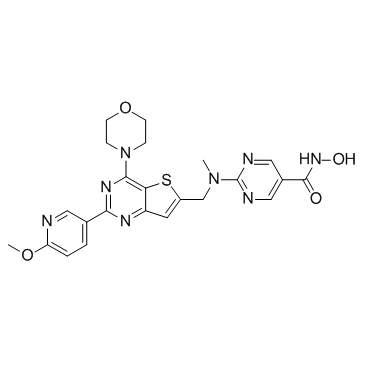1339928-25-4
| Name | N-hydroxy-2-[[2-(6-methoxypyridin-3-yl)-4-morpholin-4-ylthieno[3,2-d]pyrimidin-6-yl]methyl-methylamino]pyrimidine-5-carboxamide |
|---|---|
| Synonyms |
N-Hydroxy-2-[{[2-(6-methoxy-3-pyridinyl)-4-(4-morpholinyl)thieno[3,2-d]pyrimidin-6-yl]methyl}(methyl)amino]-5-pyrimidinecarboxamide
PI3K/HDAC Inhibitor centn 5-Pyrimidinecarboxamide, N-hydroxy-2-[[[2-(6-methoxy-3-pyridinyl)-4-(4-morpholinyl)thieno[3,2-d]pyrimidin-6-yl]methyl]methylamino]- CUDC-907 PI3K/HDAC Inhibitor |
| Description | Fimepinostat (CUDC-907) potently inhibits class I PI3Ks as well as classes I and II HDAC enzymes with an IC50 of 19/54/39 nM and 1.7/5.0/1.8/2.8 nM for PI3Kα/PI3Kβ/PI3Kδ and HDAC1/HDAC2/HDAC3/HDAC10 , respectively. |
|---|---|
| Related Catalog | |
| Target |
PI3Kα:19 nM (IC50) PI3Kβ:54 nM (IC50) PI3Kδ:39 nM (IC50) PI3Kγ:311 nM (IC50) HDAC1:1.7 nM (IC50) HDAC2:5 nM (IC50) HDAC3:1.8 nM (IC50) HDAC4:409 nM (IC50) HDAC5:674 nM (IC50) HDAC6:27 nM (IC50) HDAC7:426 nM (IC50) HDAC8:191 nM (IC50) HDAC9:554 nM (IC50) HDAC10:2.8 nM (IC50) HDAC11:5.4 nM (IC50) |
| In Vitro | Fimepinostat is a potent pan-inhibitor of HDAC classes I and II enzymes and observed that its potency against class I HDACs is similar to that of panobinostat and greater than that of vorinostat. Fimepinostat is also a potent inhibitor of class I PI3K kinases with an IC50 of 19, 54, and 39 nM for PI3Kα, PI3Kβ, and PI3Kδ, respectively. Fimepinostat markedly induces p21 protein in H460, a non-small cell lung cancer (NSCLC) cell line. Fimepinostat causes the reduction of both p-STAT3 (Y-705) and p-SRC in RPMI-8226 multiple myeloma cells and reduces both phosphorylated and total protein levels of MET and EGFR as well as HER2 and HER3 in H1975 NSCLC cells and BT-474 breast cancer cells, respectively. Fimepinostat induces caspase-3 and -7 activation in HCT-116 colon cancer cells in a dose-dependent manner. Fimepinostat potently inhibits the growth of cancer cells derived from both hematologic and solid tumors. Fimepinostat potently inhibits the proliferation of cells expressing either mutant or wild-type PI3K[1]. |
| In Vivo | Oral administration of Fimepinostat inhibits growth of the Daudi cancer cell xenografts in a dose-dependent manner. Tumor stasis is observed at 100 mg/kg in this model without obvious toxicity. Importantly, in the same model, Fimepinostat achieves better efficacy than GDC-0941, Vorinostat, or a combination of these 2 compounds given at their maximal tolerated doses (MTD). Furthermore, Fimepinostat causes tumor regression or stasis after intravenous (50 mg/kg) or oral administration (100 mg/kg) in a xenograft tumor model of SU-DHL4 diffuse large B-cell lymphoma (DLBCL) and causes tumor stasis in KRAS-mutant A549 NSCLC cell xenografts[1]. |
| Kinase Assay | The activities of classes I and II HDACs are measured using the Color-de-Lys assay system. The activity of PI3K is measured using the ADP-Glo luminescent kinase assay. Recombinant PI3K protein, a complex of N-terminal GST-tagged recombinant full-length human p110 and untagged recombinant full-length human p85, is coexpressed in a baculovirus-infected Sf9 cell expression system[1]. |
| Cell Assay | Human cancer cell lines are plated at densities of 5,000 to 10,000 per well in 96-well flat-bottomed plates with the recommended culture medium. The cells are then incubated with compounds (e.g.,Fimepinostat) at various concentrations for 72 hours in culture medium supplemented with 0.5% (v/v) FBS. Growth inhibition is assessed by assay of cellular ATP content using the Perkin-Elmer ATPlite kit[1]. |
| Animal Admin | Mice[1] Six- to 8-week-old female athymic (nude nu/nu CD-1) or severe combined immunodeficient (SCID) mice obtained from Charles River Laboratories are injected subcutaneously with 3 to 20×106 cells in a medium suspension of 100 to 200 μL into the right hind flank region. Varying doses of Fimepinostat, standard anticancer agents, or vehicle are administered orally or via tail vein injection as indicated. |
| References |
| Density | 1.4±0.1 g/cm3 |
|---|---|
| Molecular Formula | C23H24N8O4S |
| Molecular Weight | 508.553 |
| Exact Mass | 508.164124 |
| PSA | 170.45000 |
| LogP | 2.39 |
| Index of Refraction | 1.696 |
| Storage condition | -20℃ |
